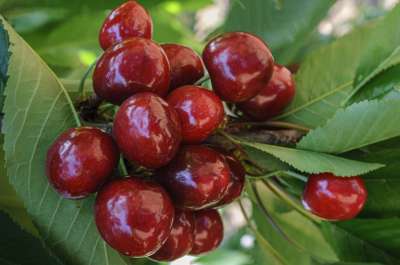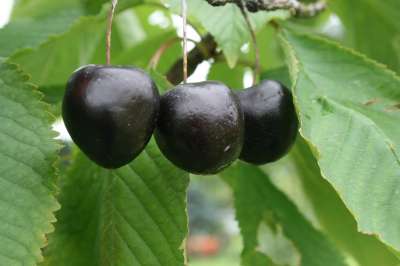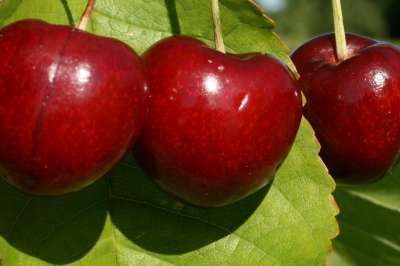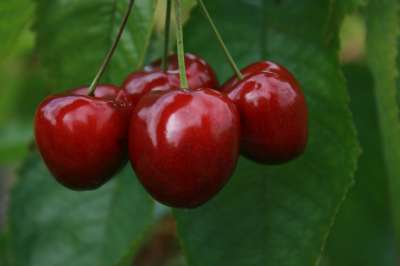Your basket is currently empty!
View our superb selection of delicious cherry trees
Cherry Trees: Selection, Planting, Pruning & Aftercare
Pollination
Sometimes a Cherry tree will flower well year after year but never actually set any fruits, or at least only a few. Often this is down to a failure in pollination. Maybe there weren’t enough pollinating insects around at blossom time or perhaps there were frosts soon afterwards. Either can prevent the flowers from ‘setting’ But the most common cause is because most cherry varieties need a partner of the correct type in order to cross-fertilize. Most of the older varieties in particular are not self pollinating and can only fruit well in pairs of different varieties.
Specialist fruit nurseries have catalogues and websites that will tell you ‘what goes with what’ as you can’t just plant any two varieties and hope for the best – incompatibility does occur. But by selecting the right pairing you will be ensured of a happy marriage with your cherry trees! For those who are only planting one tree then happily there is also a selection of self pollinating varieties that will yield well planted as solo trees. These tend to be very good varieties anyway and are also the most popular and oft-grown. Varieties such as Sunburst, Stella and Lapins Cherry Trees are self pollinating cultivars to look out for, but there are others too.
How Soon Will My Cherry Tree Crop
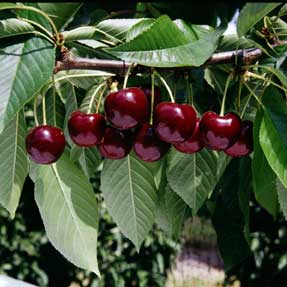
A question I am asked repeatedly by impatient gardeners! The answer is strongly dependent on local growing conditions so I can offer the answer only with reservation – it can vary.
- A bush tree on colt 2 years to start cropping, 5 years to full cropping.
- A bush tree on Gisela 5 stock – 1-2 years to start, 4-5 years for full cropping.
- A columnar tree – often yields the following season; 3 years to full cropping.
- A fan trained tree – 3 years to start, 5 years to full cropping.
- A festooned tree – 2 years to start, 4 years to full cropping.
Trees that are grown in containers are often the most precocious and speedy to start yielding. And in general, the more vigorous the tree then the longer it will be to start cropping. Dwarfing trees are quicker to fruit so that included Gisela 5 rootstock, supercolumns and festooned trees as well.
When to Plant a Cherry Tree
These days, with the advent of the container grown tree, you can plant cherry trees whenever you wish. Professionals will promote the dormant period – from Autumn through to April on average – as the best time to plant, and this still holds true. . Establishment of these is easier and more reliable and there is little need to water afterwards unless the Spring is a dry one. At this time you will be planting a bare-root tree – a tree that has been lifted from the nursery rows or fields, direct from the ground. It will come to you with it’s roots normally enclosed in a large plastic bag or some other such medium so that the roots do not dry out, but it won’t have a conventional pot around it’s roots. These trees need to be dealt with quite quickly, they will keep for a few days in a garage or shed – somewhere frost free but cool, until you are ready to plant. But for the best results plant them as soon as you can or at least trench them in temporarily with moist earth covering the roots in a quiet corner of the garden. They can then wait until you are ready to put them in. It might seem strange to the novice, planting trees during the winter when it’s cold, frosty and inclement but it does the trees no harm at all and they are much less prone to shock, being moved when they are dormant. There is no advantage to planting pot grown trees during the winter and the specialist fruit tree nursery will almost always supply you with a bare root tree at this time.
During the growing season – from Spring through to Autumn – you will be buying cherry trees in a pot or container. This allows for the convenience of planting during the better weather and establishment is generally quite fast but you do need to make sure you are around to water them very regularly for the first few weeks after planting, until they are established. An additional benefit of planting during this time is that the trees are not so sensitive to any delay in planting and generally they will keep for as long as you want them to and are ready to plant, as long as they are watered in the containers they arrive in, of course. They should be situated in a sheltered spot out of the wind and protected from too much sun as this will reduce stress whilst they are waiting to planted our properly.
Choosing the Best Rootstocks – Cherry Tree Size Chart
As with all fruit trees cherries are grafted or budded on to a rootstock which controls and determines to a large extent, the height of the tree. It is important to make an informed decision as to which rootstock is the best for your situation and requirements, infact it is probably the single most important factor in the choice of your tree[s]. The various growing methods will also be reliant on the correct rootstock as not all training methods are suited to all rootstocks. Although the range of rootstocks available is smaller than with, say, apples, there is still a good range of stocks that will suit your needs whatever they may be.
Colt rootstock
Has until recently been by far the most popular and suitable stock for general garden cultivation. It is only moderately vigorous – much less so than the older stocks which preceded it – and probably still the best choice except for rather small gardens. It is quite amenable in it’s growth which with normal pruning will come in at around 9-12’ with a similar spread. It can be contained to a little less by festooning or judicious pruning, or even be grown in a large half barrel. It promotes heavy yields and is quite cold tolerant. It is also said to impart some bacterial canker resistance. Suitable for most reasonably drained soils. Colt rootstock is the best choice for fan training, as a semi vigorous bush tree, and for festooning. Space 9-12’ apart as a bush tree. Very good for orchard planting or in a lawn.
Gisela 5 rootstock [dwarf cherry tree stock]
A new dwarfing rootstock for cherries and now already the most popular choice by far for smaller gardens and container work. Gisela 5 is very tolerant of heavier pruning and is easily maintained at a convenient 6’ or so. The spread is similar. It requires better so than Colt and is best avoided if your soil is light or impoverished. Ideal in containers, as a small bush tree in the border, as a columnar tree and in the fruit cage. Not so suited to fan training as Colt. This is the stock used for creating column trees and is the fastest stock to come into bearing. Space 6-8’ apart as a bush tree. Tabel was introduced a little before Gisela 5 and is a very dwarfing rootstock. It has proved satisfactory in gardens and can be kept even marginally smaller than the Gisela 5; mature trees of just 5-6’ have been reported. But it has fallen out of favour to a large extent and this is primarily because of the difficulty faced by nurseries in growing it to a reasonable saleable standard. There tends to be a lot of grade-outs for this rootstock which means the percentage of saleable trees is quite low or at least that they have to be grown on for a further year before they are big enough to sell which has not made it popular commercially. Tabel rootstock is still sometimes available and is an ideal container tree, but it does need good conditions to grow well and can be poorly shaped and reluctant to grow unless treated well. Use only as a small bush tree.
Gisela 6 rootstock
Is much less grown than Gisela 5 stock but offers a compromise between that stock and Colt being roughly between the two in stature. It is a heavy cropping stock and also more tolerant of poorer soils than Gisela 5. It is compatible with most varieties. Space 8’ apart as a bush tree.
Seedling cherry stocks, FI21 and Myrobalam- Vigorous cherry trees
These super-vigorous, big trees are seldom used these days as Colt is now the preferred rootstock for general orchard growing so even where a larger tree is required these stocks seem to have little place. Capable of achieving 20’ or more with ease, harvesting is difficult and it is almost impossible to protect the fruit from birds. They do have the advantage of being very hardy vigorously growing trees suitable for most soils and would perhaps have a place in a large paddock or grassland. Cropping maturity is the longest of any of the rootstock options but mature trees are capable of very heavy crops. Use only as large bush or standard trees. Space 18-20’ apart.
Soil Preparation & Planting
The soil should be in a fairly friable state and well dug over before planting with an application of blood fish and bone, bonemeal a well balanced NPK fertilizer or growmore. If planting in grass then circles of 18” across should have been removed for each tree and a hole of 18-24” dug and replaced with well friable soil mixed with some fertilizer, since the ground beneath grass is often quite compacted. It is best, but not essential, if the soil is prepared some weeks in advance of planting. To plant dig a hole that is large enough to take the roots or rootball without cramping, first drive in the stake [2 x 2” with a length of 48” is normally sufficient] place the tree in the hole so that the uppermost roots are covered by about 2” of soil. Infill with good friable soil and firm very well. It is important that no air pockets are left below the soil around the roots. Make sure the soil where you have planted is level with the surrounding ground and that there isn’t a low where water might collect as no newly planted tree likes to sit in water. When you are satisfied water the new tree in – copiously with a bucket or hose if it as pot grown tree, or just enough to settle the soil around the roots if it is a bare rooted one. Container grown Cherry trees will require watering in the early morning and evening for the first few days following planting and thereafter once a day for 3-4 weeks until established. Bare root trees should not need watering again unless they become stressed after leafing in the Spring.
A Cherry Tree in a Pot
Dwarfing trees are ideal in a container of around 25 litre capacity using a loam based compost. Dwrafing roottsock Gisela 5 is the most suitable, and a self fertile sweet variety such as Sunburst or Stella should be chocen. Water daily during the growing season and feed with luquid seaweed extract or osmocote tablets.
AFTERCARE
Pruning Cherry trees
One of the most important aspects in influencing the quantity and quality of the cherry crop is that of pruning the tree. Although the subject might seem daunting at first, I often feel that to prune badly is preferred to not pruning at all – especially with cherries that can show uncontrolled vigour quite quickly if not curbed. To have a tree growing in such a way is not necessarily a good thing as cropping will be delayed. One of the reasons for pruning all fruit trees is to promote the kind of growth that actually bears the fruit – not all growth does this. So to allow your trees to grow merrily away with no intervention not only promotes a poorly shaped tree, you might be waiting forever for a crop, or at best only get a few fruits. There are of course different pruning methods for bush, column, and fan trees.
The bush tree
Is the most commonly cultivated tree form. Regardless of whether your trees are on colt, a vigorous stock, or on a dwarfing one the principles are the same, but with the dwarfing trees you will have less growth to deal with. All pruning should be done in the Spring or early Summer, to avoid infection of silver leaf disease. But winter pruning can be unavoidable in some circumstances. If silverleaf has been a problem locally then paint main cuts with arbrex or similar.Plums and cherries can both be grown in a natural shape with very little pruning. Leave the tree almost entirely un-pruned until it settles down to fruiting, just remove the odd branches that re overcrowding the tree, if any. If you require more laterals that are produced naturally, simply shorten some of the side shoots, In later years just prune to keep the tree tidy, preferably in Summer (July).
THE DWARF PYRAMID. This is by far the best trained form for plums and cherries if you require your tree to remain an easily manageable size. Plums can even be grown in a fruit cage using this method and all trees are easily netted from birds, which is very important with cherries. After planting the tree it can be left until the Spring and as growth starts the main stem should be cut back to 4 feet from ground level. This may have been done at the nursery before despatch. During the Summer, usually in late July, all of the new side branches should be shortened to about 8 inches, pruning to a downward pointing bud, the leader (main stem) should be left un-pruned. If the side shoots appear too close together, remove some completely to leave a well shaped tree. All shoots below 18 inches from the ground should be completely cut off.
Following Spring & future seasons As growth starts in the Spring, the leader should be cut back by about half to two thirds of the new growth, pruning to a bud the opposite side to the previous year’s pruning. In future years when the tree has reached the required height of 8-9 ft the leader should be cut back in May to control at this height. In Summer each year all of the current season’s growth of each branch should be shortened to about 8 leaves, all laterals growing from these branches should be pruned to 6 leaves, any vigorous shoots near the top of the tree should be cut out.Your tree is now maintained in an easy to manage heavy cropping form
The fan trained cherry tree
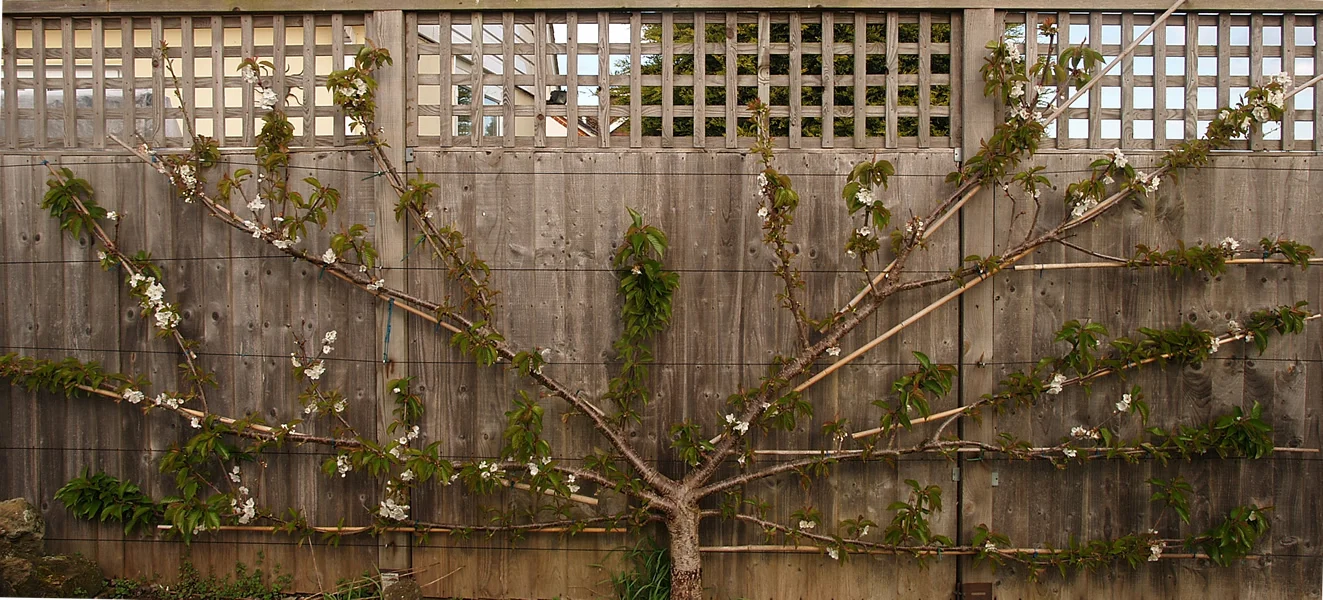 We supply nice young fan trained cherry trees in a good place to start your training. Click here to buy our fan trained cherry trees
We supply nice young fan trained cherry trees in a good place to start your training. Click here to buy our fan trained cherry trees
Start with a young year old tree and immediately remove the top third of the growth. If it is feathered [i.e. has side laterals] prune just above two conveniently placed branches; these will form the basis of your fan. Normally this is about 18” from the ground but it will depend on the positioning of 2 good feathers [branches] which you can use. It can also be varied to your own preferences and there are not hard and fast rules as to where the first branches should be – sometimes a fan will be grown with a short leg and other times it may be branched quite close to the ground. If your trees is an unfeathered maiden and does not yet have side shoots then prune to just above 2 good opposite buds and these will form your first laterals from which to work.
The first Spring shorten these two laterals to about 10-12”. You will now have a tree that looks a bit like a stumpy capital ‘T’ but don’t worry. This is a good basis from which your fan will develop. These two shortened side laterals will now produce several new upwardly mobile leaders during the course of the growing season. Leave them be until the next Spring and then stand back and survey your tree. Most of the work will now have been done but you will need to remove any new growths that are heading towards the wall or fence and any that are crossing or too congested. Having done this you should now have a nicely balanced tree – congratulations, your fan shaped tree has been trained!
Later that summer, and in subsequent summers, you can shorten again a selection of less important laterals and you can also trim the top most growths so that the tree stays within the boundaries of your wall or fence. Finally, in Autumn of the same year trim again the laterals that you shortened earlier in the summer, to about 3 pairs of leaves. You will find fruit buds will form on these shortened branches to carry next years crop.
The columnar cherry tree
Is the easiest growing method to prune. Pruning takes place in the second half of the summer and is simply a matter of trimming back all of the side growths to about 3”. Established trees only need to be pruned once a year but young trees show more vigour and you may need to go over them again in late Autumn. In subsequent years the practice is continued late each summer. Flower buds form on the base of the previous years growth. The leader can be shortened once a year, at the same time, if desired and to keep it within an acceptable height. This promotes better branching lower down and a new leader will form from a bud just below where you cut.
If you tree has any bald patches along the trunk, which can happen especially lower down, you can encourage dormant buds to shoot by nicking the bark with a sharp knife just above the bud. This often encourages them to shoot.
How long does it take to grow a cherry tree to fruiting age
A reasonable question we often get asked! Remember that the more dwarfing the tree, then the more quickly it will bear fruit. Sometimes it is assumed that a vigorous tree that grows more quickly will crop sooner, but the reverse is actually true as a quickly growing tree will be sending out long vigorous growths but not the type of growth that will actually fruit until it is properly mature. For a dwarfing stock such as Gisela 5 you can often get fruits within 2 years of planting, sometimes even the first year following planting. For more vigorous stocks such as Colt and F121 the in is 3 years, or maybe 4.
Planting younger trees is your route to a quicker crop. Young trees establish more quickly than older ones and receive less of a ‘check’ after planting, and will go on to fruit more quickly as a result.



